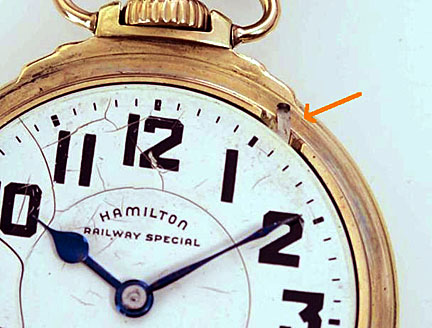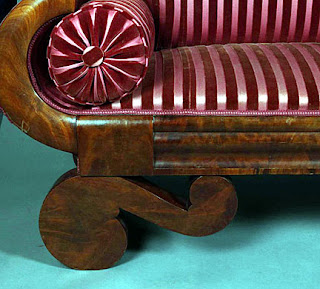 QUESTION: My grandfather worked as a conductor on the Pennsylvania Railroad. When he died some years ago, I inherited his pocket watch. For a long time, I thought it was just another old pocket watch. Then a friend, who’s father was a watch repairman, told me it was a special kind of pocket watch—a railroad pocket watch. Other than that, he didn’t know why it was so special. Can you give me some insight into antique and vintage railroad watches?
QUESTION: My grandfather worked as a conductor on the Pennsylvania Railroad. When he died some years ago, I inherited his pocket watch. For a long time, I thought it was just another old pocket watch. Then a friend, who’s father was a watch repairman, told me it was a special kind of pocket watch—a railroad pocket watch. Other than that, he didn’t know why it was so special. Can you give me some insight into antique and vintage railroad watches?
ANSWER: The answer to your question goes back to the last decade of the 19th century. On April 19, 1891, a train engineer's watch stopped for four minutes and then started again. This temporary mechanical failure resulted in a train wreck that killed nine people in Kipton, Ohio. The railroads set up a commission to create new standards for the railroad pocket watch, to be used by all railroads.
 A railroad grade pocket watch was a watch that a particular railroad approved for use by its engineers and conductors.
A railroad grade pocket watch was a watch that a particular railroad approved for use by its engineers and conductors.
The Railroad Commission required every engineer to have his pocket watch inspected regularly and to submit a certificate stating its reliability to his supervisors. When there was only one track for trains barreling in both directions, being on time was a matter of life and death. As the Kipton wreck proved, an engineer's railroad watch being off by as little as four minutes could mean disaster.
 The new standards dictated that a railroad pocket watch had to have at least 15 jewels. After 1886, the number of jewels increased. They also had to be accurate to within 30 seconds per week, as well as have a white dial—although the railroads allowed silvered dials until around 1910—with black Arabic numbers for each minute delineated; adjust to five positions, and be temperature compensated.
The new standards dictated that a railroad pocket watch had to have at least 15 jewels. After 1886, the number of jewels increased. They also had to be accurate to within 30 seconds per week, as well as have a white dial—although the railroads allowed silvered dials until around 1910—with black Arabic numbers for each minute delineated; adjust to five positions, and be temperature compensated.
Although a pocket watch’s size, ranging from 0 to 23, didn’t refer to its width or length or casing but rather to the size of its movement, to meet railroad requirements, a watch's movement had to be either a size 16 (1 7/10 inches) or a size 18 (1 23/30inches).
 Manufacturers sometimes broke the rules and made railroad watches with Roman numerals. The last two requirements were critical. As the early watchmakers discovered, not only could cold and heat cause a watch’s movement to slow or speed up, but so did the watch's position. Imagine a conductor trying to carry a watch in one position all the time, especially while working on a train. Railroad watches had to stand up to constant abuse from the jarring and swaying of early trains.
Manufacturers sometimes broke the rules and made railroad watches with Roman numerals. The last two requirements were critical. As the early watchmakers discovered, not only could cold and heat cause a watch’s movement to slow or speed up, but so did the watch's position. Imagine a conductor trying to carry a watch in one position all the time, especially while working on a train. Railroad watches had to stand up to constant abuse from the jarring and swaying of early trains.
Contrary to common belief, there were many regulations in place before railroad officials commissioned Webb C. Ball to create a standard set of railroad watch qualifiers in the 1890’s.
Before then, and until the entire railroad industry accepted Ball’s standards, different railroads had different standards for the watches their crews used. One line might have had a list of accepted makes and models while another might have only listed necessary features or timekeeping performance thresholds. This made evaluating older watches as railroad grade a difficult task, because a watch may have met the standards of one company but not another.
 As the rail industry grew in the United States, the number of active trains grew with it. In order to use a particular track efficiently, railroads had to create time schedules identifying when each section of that track was safe to use. The timekeeping accuracy of the engineer’s and conductor’s watches was crucial if two trains were moving in opposite directions. If one of the two engineers’ or conductors’ watches were keeping bad time, a collision could occur. Railroad watches became known as “standard” watches because they met a railroad’s standard of timekeeping.
As the rail industry grew in the United States, the number of active trains grew with it. In order to use a particular track efficiently, railroads had to create time schedules identifying when each section of that track was safe to use. The timekeeping accuracy of the engineer’s and conductor’s watches was crucial if two trains were moving in opposite directions. If one of the two engineers’ or conductors’ watches were keeping bad time, a collision could occur. Railroad watches became known as “standard” watches because they met a railroad’s standard of timekeeping.
Companies like Waltham, Elgin, and Hamilton made the “best” railroad watches after 1900. An important part of standard watch regulations included service intervals and testing, but there was also a list of features that almost all railroad watches shared.
The most prominent feature of 1900’s railroad watches was their lever actuated setting mechanisms–commonly referred to as "lever-set.". Most watches were put in time-setting mode by pulling the crown, or winding knob, away from the watch, then pushing the crown back towards the watch to return to winding mode—referred to as "pendant-set."
A lever-set mechanism required the user to remove the bezel of the watch—the convex glass protecting the dial---and engage a lever to place the watch in setting mode. This tedious process of removing the bezel had a very important purpose. It ensured that the time on the watch was never accidentally changed by catching the winding knob on a pocket or any number of other unintentional situations.
 Another important feature of railroad watches was their big, bold, black, Arabic numerals on highly contrasting white enamel dials with large bold hands. This feature made telling the time as clear and easy as possible while creating a distinctive and functional railroad watch design.
Another important feature of railroad watches was their big, bold, black, Arabic numerals on highly contrasting white enamel dials with large bold hands. This feature made telling the time as clear and easy as possible while creating a distinctive and functional railroad watch design.
 Mechanically speaking, almost all 1900’s railroad watches shared a number of performance and reliability enhancing features. Most had a fixed regulator to avoid timekeeping variation from impact, a double roller balance wheel to avoid going out of action, 19 or more jewels to reduce friction and increase consistency of the gear train, timekeeping adjustment in five or more positions to make sure the watch kept accurate time regardless of its orientation, and adjustment for temperature to ensure accuracy in a variety of climates. Many railroad watches had solid gold or gold plated gear trains and jewel settings to reduce the effects of magnetism as well as reduce tarnishing, and later watches had features such as magnetically resistant balance wheels.
Mechanically speaking, almost all 1900’s railroad watches shared a number of performance and reliability enhancing features. Most had a fixed regulator to avoid timekeeping variation from impact, a double roller balance wheel to avoid going out of action, 19 or more jewels to reduce friction and increase consistency of the gear train, timekeeping adjustment in five or more positions to make sure the watch kept accurate time regardless of its orientation, and adjustment for temperature to ensure accuracy in a variety of climates. Many railroad watches had solid gold or gold plated gear trains and jewel settings to reduce the effects of magnetism as well as reduce tarnishing, and later watches had features such as magnetically resistant balance wheels.
Although there were many other fine pocket watches made in America, the quality of the workmanship made them second only to chronometers for being precise—they had to be.
To read more articles on antiques, please visit the Antiques Articles section of my Web site. And to stay up to the minute on antiques and collectibles, please join the over 30,000 readers by following my free online magazine, #TheAntiquesAlmanac. Learn more about "Coffee--The Brew of Life" in the 2023 Summer Edition, online now. And to read daily posts about unique objects from the past and their histories, like the #Antiques and More Collection on Facebook.







